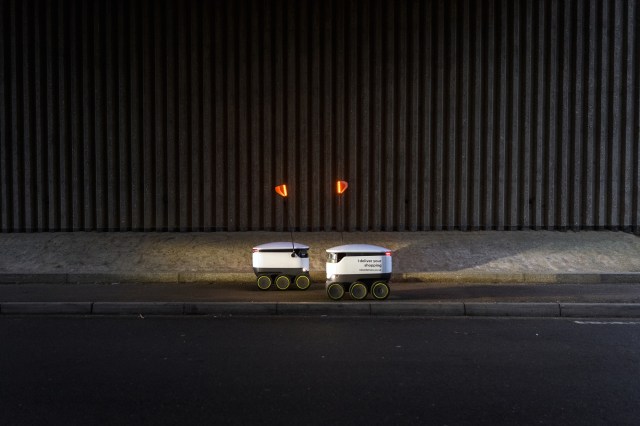Two supermarket delivery robots. Credit: Leon Neal/Getty

Airships are stately and sinister in equal measure. Moving slowly but deliberately, their great volume dominates the sky and everything below it. Aeroplanes, though so much more significant to our way of life, are either on the ground or moving rapidly out of view.
Last week, a video clip made the rounds on Twitter, provoking dismay. It showed an airship emblazoned with the Amazon logo, hovering with intent over a city. It manoeuvred into position – and then gave birth to a swarm of buzzing drones. Each of the flying robots carried a package, swooping off and down to deliver it to some address below.
The clip was soon revealed to be a digitally-conjured illusion – but I wonder if the sighs of relief were mixed with a little bit of disappointment. While some people fear the growing power of companies such as Amazon, just about all of us love the convenience of door-to-door deliveries. Fully automating the process promises a whole new level of speed and affordability (not to mention the absence of delivery vehicles choking up the street).
New delivery companies and technologies are attracting billions in investment – as one might expect of a growing market with a lot of room still to grow.
In the US, online purchases still accounts for only 5% of retail sales. In part, that’s because some things are much harder to deliver than others. As Heather Haddon explains in the Wall Street Journal, fresh food and restaurant meals are especially difficult:
“Unlike easy-to-ship household items, groceries must be packaged carefully and sent in refrigerated trucks. That makes the ‘last mile’ of the delivery process—from the warehouse to the consumer’s door—a costly, often perilous journey. The average online grocery order contains dozens of items, with different temperature and handling requirements.
“Restaurant meals must likewise be packed in special containers and delivered within a short window.”
And yet because these are frequently-made, routine purchases (certainly in the case of groceries and, increasingly, for restaurant meals too), the appetite for home delivery is especially keen:
“Online grocery sales are expected to grow to around $86 billion in 2022 from $17 billion in 2017, according to a report from UBS Group AG. Investment firm William Blair & Co. estimated sales of online restaurant delivery will grow to $62 billion in 2022 from about $25 billion today.”
Almost a third of restaurant meals are now consumed at home in the US. The home delivery of fast-food has long been an established part of that market, but thanks to Deliveroo-type operations, ‘slow food’ is going mobile too.
In theory, this is good news all round. Customers get convenience; grocers and restaurants expand their markets; and tech entrepreneurs turn their start-ups into thriving new enterprises. But at what cost?
Haddon quotes figures showing that the cost to the vendor of delivering food is typically higher than what customers are willing to pay. Therefore margins in a notoriously low-margin sector are being squeezed even harder. Nevertheless, they can’t afford not to participate in this growing market.
Economies of scale are vital to minimising the cost of delivery. While major food retailers and restaurant chains can more easily run their own delivery services, smaller operations have to rely on third party delivery services – at a cost to the bottom line and to their commercial independence:
“Food sellers pay the services an average fee of 10% to 25% on each order, which means the actual deliveries often lose money. Better placement on the services’ websites or apps costs even more…
“Many restaurants and grocers that work with third parties also lose control over customer data, which food apps can use to drive customers to other outlets.”
However, it should also be said the food delivery business is a highly competitive one – full of companies with high valuations but no profits.
Obviously, none of this is good news for the low-paid workers of the retail, catering and delivery sectors.
It would seem that the only winners in all of this are us consumers – with everyone else falling over themselves to cater to our demands. But I think we’ll pay a price too.
Be Here Now by Ram Dass was first published in 1971, introducing its largely western readership to Hindu philosophy and spirituality. It is a classic of the genre, which inspired a song of the same name by George Harrison and the 1997 album by Oasis. In Dass’s words, the title of his book means “being in the moment, at ease with whatever comes one’s way”, so that one can “be present to love and serve others and to express unconditional love in the world”.
I’ve got a horrible feeling that, before long, ‘be here now’ will become the slogan for a delivery company – its original meaning twisted out of recognition. Instead of a reminder to oneself, the three word phrase is becoming our impatient instruction to the world: serve me without delay or heed to the wider consequences.










Join the discussion
Join like minded readers that support our journalism by becoming a paid subscriber
To join the discussion in the comments, become a paid subscriber.
Join like minded readers that support our journalism, read unlimited articles and enjoy other subscriber-only benefits.
Subscribe